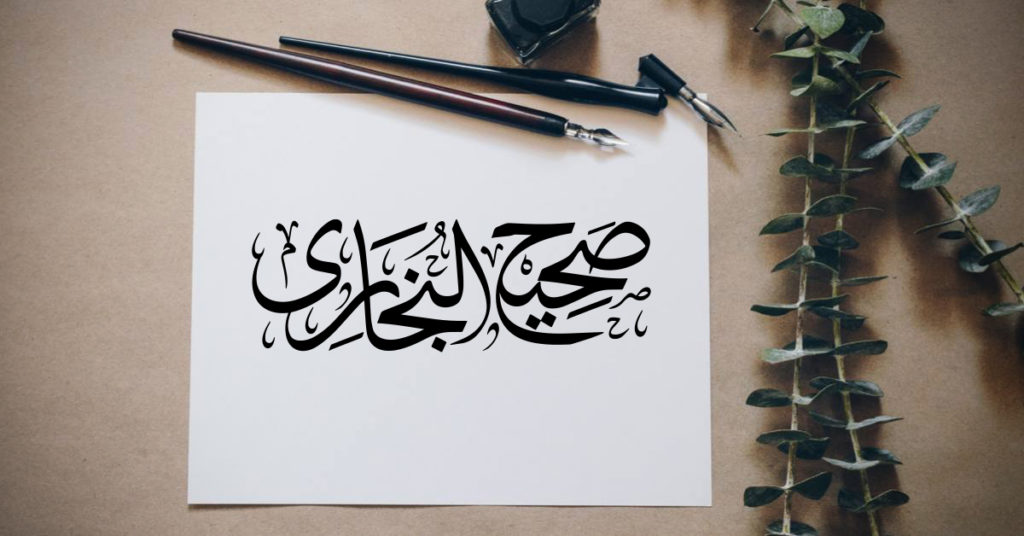The current questioning of the authenticity of the transmission of Ṣaḥīḥ al-Bukhārī, as bizarre as it is, has allowed Muslim scholars and laymen the chance to appreciate the erudition of the scholars of the past. We have always been taught of the greatness of the likes of Abū Ḥanīfa, al-Shāfi’ī, al-Bukhārī, etc, and their many virtues but few have been able to experience their greatness first hand.
The simple reason is that the more technical a science one’s expertise is in, the more difficult it is for the masses to appreciate. The transmission of books through transcribing, dictation, editing is an alien science to the average 21st century mind due to the invention of the printing press. So, when told that the original work of a figure of the past is lost and the copies of that work have differences, it is easy to understand why the average person would be sceptical.
But the thinking person should ask, how many original signed copies of works do we have of historical figures? If the answer is very very few (which would be accurate), how is that scholars attribute books and statements to historical figures with such conviction? Has there been a huge conspiracy?1One such Western academic who questioned the origins of the Ṣaḥīḥ was Norman Calder, but one should note that his criticism extended to Muwaṭṭa’ of Mālik as well as the Mudawwanah of Saḥnūn. Calder’s methods were questioned by subsequent academics, see Calder, Norman (1993) Studies in Early Muslim Jurisprudence, Oxford: Clarendon Press, pp.1-38, Melcher, Christopher, Bukhārī and Early Ḥadīth Criticism, Journal of the American Oriental Society, Vol. 121, No. 1 (Jan.- Mar., 2001), pp.7-19. This is not to deny that there have been false attributions made by scholars, but only that one should have a consistent and scholarly methodology.
Different aspects of the transmission of Ṣaḥīḥ al-Bukhārī has been discussed by dear friend Muftī Muntaṣir Zamān and there is more to discuss which will be the aim of future articles, inshā’Allāh. The focus of the current piece is on the transmission of al-Yūnīnī; who was he, what did he do and how did it impact later scholarship on the Ṣaḥīḥ? Much of the content of this current piece has been taken from the exhaustive study by Dr Jumuʿah Fahmī entitled ‘Riwāyāt al-Jāmiʿ al-Ṣaḥīḥ wa Nusakhuhu’.2Fahmī, Jumuʿah (2013) Riwāyāt al-Jāmiʿ al-Ṣaḥīḥ wa Nusakhuhu, Qatar: Dār al-Falāḥ.
But before we enter the details of al-Yūnīnī, we must first present the objections against his transmission. Much of the arguments against the transmission of Ṣaḥīḥ al-Bukhārī (and the content of the book) has been taken from a recently published book entitled ‘Ṣaḥīḥ al-Bukhārī: Nihāyat Asṭūrah’ written by Rashīd Aylāl.3Aylāl, Rashīd (2017) Ṣaḥīḥ al-Bukhārī: Nihāyat Asṭūrah, ??: Dār al-Waṭan
It would be an understatement if it is said that this book is a great demonstration of poor scholarship. This assessment is not based on the fact that he is questioning the authority of Ṣaḥīḥ al-Bukhārī, but due to simple poor scholarship. There is selective quoting, a warped methodology, misunderstandings and even accusations of plagiarism! Whatever the case, Rashīd Aylāl fails to bring Yūnīnī in to this mass conspiracy in adding and taking away from Ṣaḥīḥ al-Bukhārī. For him the damage was done much earlier.
But recently some have attempted to cast doubt on Yūnīnī’s transmission by first stating that Yūnīnī’s recension is lost. Hence, implying that we cannot trust it. And secondly claiming that Yūnīnī had Ibn Mālik correct the grammatical errors in Ṣaḥīḥ al-Bukhārī, again implying that we cannot trust the transmission as it was replete with grammatical mistakes.
Regarding the first point; the absence of a handwritten manuscript from the author, then this demonstrates an ignorance of how classical books have been transmitted throughout the ages. Rashīd Aylāl makes it his central argument, but then also claims that there are barely any manuscripts for any of the early books dating within the first 300 years of Islam.
Those using this argument and working off Aylāl’s book should consider then the implication of such a methodology. Most, if not all of the early books of tārīkh, ḥadīth, sīrah, jarḥ wa taʿdīl etc. will become unreliable. This problem would not be restricted to early Islam, but to most of the works ascribed to historical personalities. How then were books transmitted?
The case of the Ṣaḥīḥ al-Bukhārī, as has been discussed in other articles, is a demonstrative example. Imam Bukhārī penned his collection and then dictated it to multiple students. From amongst this large group, the transmission of a few grew popular due to various factors. This was down to their closeness to Imam Bukhārī, their access to Imam Bukhārī’s original work, their competency in transmission, how long they lived (as the longer a transmitter lived, the higher number of students they would usually have) and a host of other factors.
So, it turned out that his student al-Farabrī4Due to the acceptance of Farabrī’s transmission by all the ḥadīth experts after him, he does not require specific tawthīq. Abū al-Walīd al-Bājī was one amongst the many to write on the narrators in Ṣaḥīḥ al-Bukhārī and relies on Farabrī’s transmission. This would necessitate that Bājī considered Farabrī to be a sound transmitter as otherwise one would have to conclude that he would spend years working on the narrators of a book which cannot be traced authentically back to the author!
That being said, some have attributed to Bājī words of tawthīq for Farabrī and referenced it to his ‘al-Taʿdīl wa al-Tajrīḥ’. Whereas in fact this tawthīq is not found therein, rather it was Ibn Rushayd (d.721) who mentioned Bājī’s tawthīq via his own sanad, not from a citation to a book of Bājī, see Ibn Rushayd, Abū ʿAbdullāh (n.d.) Ifādat al-Naṣīḥ, al-Dār al-Tunisiyyah, pp.14-15. became the central transmitter of the Ṣaḥīḥ al-Bukhārī because he best fulfilled those factors.
This transmission of al-Farabrī was passed down via multiple students consistently for centuries until our day. But as is expected from any human effort there were differences in the various transmissions, most of which were insignificant and had to do with the structure of the book, rather than the actual ḥadīth. These differences were approached in a scholarly manner via comparing the various transmissions, earlier book citations, comparison of other ḥadīth collections etc. The vast majority of early texts face similar problems but what makes the Ṣaḥīḥ al-Bukhārī special is the great amount of scholarly effort put into every aspect of the book.
This includes books on the narrators of the ḥadīth in the collection5Abdullāh al-Laythī lists the books written on just the narrators cited in Ṣaḥīḥ al-Bukhārī in his introduction to Aḥmad ibn Muḥammad al-Kalābādhī’s (d.393) ‘Rijāl Ṣaḥīḥ al-Bukhārī’. These include the following 1) ʿAbdullāh ibn ʿAdī (d.365) ‘Asāmī man rawā ʿanhum al-Bukhārī’, 2) ʿAlī ibn ʿUmar al-Dāraquṭnī (d.385) ‘Dhikr asmā’ al-Tābiʿīn wa man baʿdahum min man ṣaḥḥat 6riwāyatuhu min al-thiqāt ʿinda Muḥammad ibn Ismāʿīl al-Bukhārī’, 3) Aḥmad ibn Muḥammad al-Kalābādhī (d.393) ‘Rijāl Ṣaḥīḥ al-Bukhārī’, 4) Abū al-Walīd al-Bājī (d. 474) ‘Al-taʿdīl wa al-tajrīḥ liman kharraja ʿanhu al-Bukhārī fī al-Jāmiʿ al-Ṣaḥīḥ’, 5) ʿAbd al-Raḥmān ibn al-Jawzī (d.597) ‘Aḥādīth al-Taʿlīq’, 6) Abū al-Faḍā’il al-Ṣāghānī (d.650) ‘Asāmī shuyūkh al-Bukhārī’, 7) Ibn Ḥajar al-ʿAsqalānī (d.852) ‘Taghlīq al-Taʿlīq’, al-Laythī goes onto to list some twenty five titles, see intro to al-Kalābādhī, Aḥmad ibn Muḥammad (1987) ‘Rijāl Ṣaḥīḥ al-Bukhārī’, Beirut: Dār al-Ma’rifah, pp.6-8., critically engaging with the authenticity of certain ḥadīth,7The most famous critique of the Ṣaḥīḥayn came from ʿAlī ibn ʿUmar al-Dāraquṭnī, see al-Dāraquṭnī, ‘Alī ibn Muḥammad (1985) al-ilzāmāt wa al-tatabbuʿ, Beirut: Dār al-Kutub al-ʿIlmiyyah, Ed. Muqbil ibn Hādī al-Wādi’ī. the chapter headings,8One of the earliest books written specifically dealing with the chapter headings was by Ibn al-Munayyir (d.683), this book was utilized by Ibn Ḥajar when writing his commentary on Bukhārī, Ibn al-Munayyir, Nāṣir al-Dīn (1987) al-mutawārī ʿalā tarājim abwāb al-Bukhārī, Kuwait: Maktabat al-Maʿlā, Ed. Ṣalāḥ al-Dīn Maqbūl attempts to decipher the methodology of Bukhārī, collections of ḥadīth based on Bukhārī’s conditions and generic commentaries dealing with all of the above and more.
This point also refutes the notion that due to an absence of any explicit praise (tawthīq) for al-Farabrī makes him unreliable. As major ḥadīth experts relied on his transmission to not only transmit the Ṣaḥīḥ al-Bukhārī, but to write books on the Ṣaḥīḥ. It would be ridiculous to suggest that scholars would sacrifice years of their lives to work on a book whose main transmitter is unreliable!
Who was Yūnīnī?
This now brings us to Yūnīnī’s transmission of Ṣaḥīḥ al-Bukhārī. Yūnīnī,9There are many sources which discuss the biography of Yūnīnī, see al-Dhahabī, Shams al-Dīn, Tārīkh al-Islām, 53/18-19, al-Muʿjam al-Mukhtaṣṣ, pp.168-169, Muʿjam al-Shuyūkh, pp.376-377, Tadhkirat al-Ḥuffāẓ, 4/1500, al-Muntaqā fī Sard al-Kunā, 1/188, others include al-Ṣafadī, al-Wāfī bi al-Wafayāt, 21/421, al-Yāfi’ī, Mir’āt al-Janān, 4/235, Ibn Rajab, Dhayl Ṭabaqāt al-Ḥanābilah, 4/329, Taqī al-Dīn al-Fāsī, Dhayl al-Taqyīd, 3/210, Ibn Ḥajar, al-Durur al-Kāminah, 3/98, Ibn Taghrībirdī, al-Nujūm al-Ẓāhirah, 8/198, Ibn Mufliḥ, al-Maqṣad al-Arshad, 2/259, al-ʿUlaymī, al-Durr al-Munaḍḍad, 2/450, Ibn ‘Imād, Shadharāt al-Dhahab, 6/3, al-Zabīdī, Tāj al-‘Urūs, 18/602 and others, see Jumaʿah, Riwāyāt al-Jāmiʿ, p.655. The purpose of bringing these citations is to demonstrate the fame and acceptance of al-Yūnīnī. full name ʿAlī Sharaf al-Dīn Abū al-Ḥusayn,10Al-Qaṭallānī refers to him as Abū al-Ḥasan, but this is a mistake as pointed out by Aḥmad Shākir, see Aḥmad Shākir, al-Naqd: al-Nuskhat al-Yūnīniyyah min Ṣaḥīḥ al-Bukhārī, ʿĀlam al-Kutub, p.3. was a Ḥadīth specialist from the Ḥanbalī madhhab.
He was born in Baalbek in the year 621. His father, as well as his brother, were famous Ḥanbalī scholars which meant that Sharaf al-Dīn al-Yūnīnī was born into a scholarly family. After completing his travels in the pursuit of knowledge, he began teaching in the ḥadīth faculty at the Madrasah al-Ẓāhiriyyah in Damascus. He taught their multiple classics such as ‘al-Muḥaddith al-Fāṣil’ of al-Rāmahurmuzī and ‘Musnad al-Shāfi’ī’. His students include the likes of Ibn Taymiyyah and al-Dhahabī.
Despite his teaching and transmitting various books, it was his effort on Ṣaḥīḥ al-Bukhārī which cemented his authority in ḥadīth. Taqī al-Dīn al-Fāsī describes him as the greatest to have transmitted it.11Al-Fāsī, Dhayl al-Taqyīd, 2/210-211. Ibn Rajab states that he narrates a lot and the Ḥuffāẓ of his age took ḥadīth from him.12Ibn Rajab, Dhayl Ṭabaqāt al-Ḥanābilah, 2/346. He did not write much in terms of his own works except for ‘al-Mashyakhah’ which is a list of his teachers. He died on a Friday, the 5th13Jumaʿah cites the date of death as the 5th, although others state that he was attacked on the 5th and actually died on the 10th or 11th, see Quiring-Zoche, Rosemarie, How al-Bukhārī’s Ṣaḥīḥ was edited in the middle ages: ‘Alī al-Yūnīnī and his ‘’Rumz’’, Bulletin d’études orientales T. 50 (1998), pp. 191-222. Ramaḍān 701 when a mad man attacked him. Allāh have mercy on him.
Yūnīnī’s Transmission of the Ṣaḥīḥ
As for Yūnīnī’s transmission of Bukhārī, then the aim of Yūnīnī’s recension has been explained by himself.14The full text of Yūnīnī is provided by Jumaʿah as well as al-‘Utaybī, see Jumaʿah, Riwāyāt, pp.667-677, al-‘Utaybī, Ḥāfiẓ ibn Jabr (2018) Kitāb Jabr, Cairo: Dār al-Ta’ṣīl, pp.145-153. The basic idea was to bring together the various transmission and provide a critical edition of the Ṣaḥīḥ. Jumaʿah has attempted to summarize Yūnīnī’s transmitted (riwāyāt) sources in a diagram (I have provided an English translation of that diagram at the end). As for the manuscripts that he had available to him, then he used five.
1) A copy of the transmission of Abū al-Waqt.15Al-ʿUtaybī demonstrates that Yūnīnī’s mother-text (aṣl) that he worked from was ʿAbd al-Ghanī al-Maqdisī’s, who in turn worked from the aṣl of Abū al-Waqt, see al-ʿUtaybī, Kitāb Jabr.
2) A copy of the transmission of Abū Dharr al-Harawī.
3) A copy of the transmission of al-Aṣīlī.
4) A copy of the transmission of Ibn ʿAsākir.
5) A copy of the transmission of Abū Saʿd al-Samʿānī.
Gathering those different transmissions and manuscripts, Yūnīnī clarified in which manuscript or transmission a word or sentence was found and in which there was something missing. He alerted the reader to this via formulating an elaborate key.
The original work penned by Yūnīnī is now lost, but multiple students had transcribed his work. Aḥmad ibn Muḥammad al-Qasṭallānī’s (d.923) famous commentary of Ṣaḥīḥ al-Bukhārī ‘Irshād al-Sārī’ was reliant on Yūnīnī’s transmission. When writing, he did not initially have access to the original copy of Yūnīnī. He was most impressed by Shams al-Dīn al-Ghazūlī’s (d.777)16Al-ʿAsqalānī, Ibn Ḥajar (1972) al-Durar al-Kāminah fī Aʿyān al-Mi’at al-Thāminah, Hyderabad: Dā’irat al-Maʿārif al-ʿUthmāniyyah (6 vols), 5/47.copy, such that it may have been better than the original.
He had two other copies and he compared the three when writing his commentary. Al-Qasṭallānī mentions that later he happened to come across a volume of the original copy of Yūnīnī, with which he compared the copies he had.17Al-Qasṭallānī, Aḥmad ibn Muḥammad (2017) Irshād al-Sārī fī Sharḥ Ṣaḥīḥ al-Bukhārī, Beirut: Dār al-Kutub al-ʿIlmiyyah (15 vols) 1/58. The second part of Ghazūlī’s copy is still available in Dār al-Kutub al-Miṣriyyah.18Jumaʿah, Riwāyāt, p.696. Another person to have copied Yūnīnī’s work was Shihāb al-Dīn al-Nuwayrī (d.733).
He himself states that he made his copy using Yūnīnī’s original work seven times.19Al-Nuwayrī, Shihāb al-Dīn (2003) Nihāyat al-Arab fi Funūn al-Adab, Cairo: Dār al-Kutub wa al-Wathā’iq al-Qawmiyyah (33 vols) 32/18, also cited in al-ʿUtaybī, Kitāb Jabr, p.411. Al-Nuwayrī’s transmission was copied and taught by many of the major ḥadīth scholars after him. His fifth writing of Yūnīnī’s transmission became the central source of listening (samāʿ) of Bukhārī in Egypt.20al-ʿUtaybī, Kitāb Jabr, p.411. The original manuscript of al-Nuwayrī can be found.21For a list of the available manuscripts of copies of Yūnīnī’s transmission, see Abū Ḥassān al-Salafī, al-Tuḥaf al-Salafiyyah fī Jamʿ Furūʿ al-Yūnīniyyah, found here http://majles.alukah.net/t77426/(last accessed 16/08/2018).
Much more can be said regarding the preservation of Yūnīnī’s work and the list of scholars and manuscripts that are available right down to our time. Rather than allowing someone to doubt such a transmission, the effort to preserve and critical assess previous works allows us to appreciate the scholarly rigor of our tradition. A last point regarding this to note is that no person, Muslim or non-Muslim (to my knowledge) has ever made this claim that due to the absence of the original Yūnīnī’s handwritten manuscript, one should doubt whether we have his work preserved.
Ibn Mālik and Yūnīnī’s Transmission
What was Ibn Mālik’s role in Yūnīnī’s work? Jamāl al-Dīn Muḥammad ibn Mālik was an Andalusian linguist born in the year 600. His biographers described him as being ‘unique in his era’ (wāḥid ʿaṣrihi).22The biographical information is taken from ʿAbdullāh Nāṣīr’s intro to the ‘Shawāhid’, see Ibn Mālik, Jamāl al-Dīn (2011) Shawāhid al-Tawḍīḥ wa al-Taṣḥīḥ li Mushkilāt al-Jāmiʿ al-Ṣaḥīḥ, Beirut: Dār al-Bashā’ir, p.9. In the year 666, Yūnīnī held multiple gatherings throughout that year. The total number of gatherings ended up being seventy-one. Ibn Mālik attended these sessions and himself explains his role, a group of notable scholars attended the transmission session.
‘[We were] looking through the relied upon manuscripts [of Ṣaḥīḥ al-Bukhārī] and whenever a word came in which there was ambiguity (dhū ishkāl), I clarified the correct usage and the accurate pronunciation was place based on my knowledge of the Arabic language. Whatever required a lengthier elaboration, I delayed its case to a treatise in which I brought detail…’ This treatise mentioned at the end is referring to his ‘Shawāhid’.
The method employed by Ibn Mālik was to bring the phrase or word in which there is some ambiguity or a difference of opinion, he then brings corroborating evidences (shawāhid) to support the different readings. It is interesting to note that alongside the usage of Qur’ānic verses and classical poetry, many of these shawāhid are other ḥadīth, demonstrating the preservation of ḥadīth to be a source for correct Arabic.23The editor counts eighty-two ḥadīth. Ibn Mālik cites as evidence and mentions the fact that Ibn Mālik was famous for his using of ḥadīth to prove grammatical points, Shawāhid, p.19.
At some points, the ḥadīth as found in Bukhārī are used as evidences for the opinions of certain linguists. In the ḥadīth of ʿAbdullāh ibn ʿUmar as found in the transmission of Kushmīhanī, Ibn Mālik states that the wording of the ḥadīth is an evidence against the linguist al-Farrā’ (d.20724There is some dispute on the year of his death, the mentioned date was taken from al-Dhahabī, see al-Dhahabī, Shams al-Dīn (2006) Siyar Aʿlām al-Nubalā’, Cairo: Dār al-Ḥadīth (18 vols) 9/292.).25Ibn Mālik, Shawāhid, p.177. The simple point being stressed here is that the notion that Ibn Mālik had to come along and rectify Bukhārī’s text due to so many grammatical errors is absurd to say the least.
To conclude, the transmission of Ṣaḥīḥ al-Bukhārī and the efforts the scholars of the past made on it is a testament to the erudition of our scholarly heritage. It was not a tradition of blind acceptance, but of critical engagement and asking the difficult questions. This is not to claim that there is no room for further investigation, rather to the contrary, we should also engage critically with our tradition but with a consistent scholarly methodology in pursuit for the truth. Not ad hoc methods to forward an agenda or world view.
Footnotes
- 1One such Western academic who questioned the origins of the Ṣaḥīḥ was Norman Calder, but one should note that his criticism extended to Muwaṭṭa’ of Mālik as well as the Mudawwanah of Saḥnūn. Calder’s methods were questioned by subsequent academics, see Calder, Norman (1993) Studies in Early Muslim Jurisprudence, Oxford: Clarendon Press, pp.1-38, Melcher, Christopher, Bukhārī and Early Ḥadīth Criticism, Journal of the American Oriental Society, Vol. 121, No. 1 (Jan.- Mar., 2001), pp.7-19.
- 2Fahmī, Jumuʿah (2013) Riwāyāt al-Jāmiʿ al-Ṣaḥīḥ wa Nusakhuhu, Qatar: Dār al-Falāḥ.
- 3Aylāl, Rashīd (2017) Ṣaḥīḥ al-Bukhārī: Nihāyat Asṭūrah, ??: Dār al-Waṭan
- 4Due to the acceptance of Farabrī’s transmission by all the ḥadīth experts after him, he does not require specific tawthīq. Abū al-Walīd al-Bājī was one amongst the many to write on the narrators in Ṣaḥīḥ al-Bukhārī and relies on Farabrī’s transmission. This would necessitate that Bājī considered Farabrī to be a sound transmitter as otherwise one would have to conclude that he would spend years working on the narrators of a book which cannot be traced authentically back to the author!
That being said, some have attributed to Bājī words of tawthīq for Farabrī and referenced it to his ‘al-Taʿdīl wa al-Tajrīḥ’. Whereas in fact this tawthīq is not found therein, rather it was Ibn Rushayd (d.721) who mentioned Bājī’s tawthīq via his own sanad, not from a citation to a book of Bājī, see Ibn Rushayd, Abū ʿAbdullāh (n.d.) Ifādat al-Naṣīḥ, al-Dār al-Tunisiyyah, pp.14-15. - 5Abdullāh al-Laythī lists the books written on just the narrators cited in Ṣaḥīḥ al-Bukhārī in his introduction to Aḥmad ibn Muḥammad al-Kalābādhī’s (d.393) ‘Rijāl Ṣaḥīḥ al-Bukhārī’. These include the following 1) ʿAbdullāh ibn ʿAdī (d.365) ‘Asāmī man rawā ʿanhum al-Bukhārī’, 2) ʿAlī ibn ʿUmar al-Dāraquṭnī (d.385) ‘Dhikr asmā’ al-Tābiʿīn wa man baʿdahum min man ṣaḥḥat
- 6riwāyatuhu min al-thiqāt ʿinda Muḥammad ibn Ismāʿīl al-Bukhārī’, 3) Aḥmad ibn Muḥammad al-Kalābādhī (d.393) ‘Rijāl Ṣaḥīḥ al-Bukhārī’, 4) Abū al-Walīd al-Bājī (d. 474) ‘Al-taʿdīl wa al-tajrīḥ liman kharraja ʿanhu al-Bukhārī fī al-Jāmiʿ al-Ṣaḥīḥ’, 5) ʿAbd al-Raḥmān ibn al-Jawzī (d.597) ‘Aḥādīth al-Taʿlīq’, 6) Abū al-Faḍā’il al-Ṣāghānī (d.650) ‘Asāmī shuyūkh al-Bukhārī’, 7) Ibn Ḥajar al-ʿAsqalānī (d.852) ‘Taghlīq al-Taʿlīq’, al-Laythī goes onto to list some twenty five titles, see intro to al-Kalābādhī, Aḥmad ibn Muḥammad (1987) ‘Rijāl Ṣaḥīḥ al-Bukhārī’, Beirut: Dār al-Ma’rifah, pp.6-8.
- 7The most famous critique of the Ṣaḥīḥayn came from ʿAlī ibn ʿUmar al-Dāraquṭnī, see al-Dāraquṭnī, ‘Alī ibn Muḥammad (1985) al-ilzāmāt wa al-tatabbuʿ, Beirut: Dār al-Kutub al-ʿIlmiyyah, Ed. Muqbil ibn Hādī al-Wādi’ī.
- 8One of the earliest books written specifically dealing with the chapter headings was by Ibn al-Munayyir (d.683), this book was utilized by Ibn Ḥajar when writing his commentary on Bukhārī, Ibn al-Munayyir, Nāṣir al-Dīn (1987) al-mutawārī ʿalā tarājim abwāb al-Bukhārī, Kuwait: Maktabat al-Maʿlā, Ed. Ṣalāḥ al-Dīn Maqbūl
- 9There are many sources which discuss the biography of Yūnīnī, see al-Dhahabī, Shams al-Dīn, Tārīkh al-Islām, 53/18-19, al-Muʿjam al-Mukhtaṣṣ, pp.168-169, Muʿjam al-Shuyūkh, pp.376-377, Tadhkirat al-Ḥuffāẓ, 4/1500, al-Muntaqā fī Sard al-Kunā, 1/188, others include al-Ṣafadī, al-Wāfī bi al-Wafayāt, 21/421, al-Yāfi’ī, Mir’āt al-Janān, 4/235, Ibn Rajab, Dhayl Ṭabaqāt al-Ḥanābilah, 4/329, Taqī al-Dīn al-Fāsī, Dhayl al-Taqyīd, 3/210, Ibn Ḥajar, al-Durur al-Kāminah, 3/98, Ibn Taghrībirdī, al-Nujūm al-Ẓāhirah, 8/198, Ibn Mufliḥ, al-Maqṣad al-Arshad, 2/259, al-ʿUlaymī, al-Durr al-Munaḍḍad, 2/450, Ibn ‘Imād, Shadharāt al-Dhahab, 6/3, al-Zabīdī, Tāj al-‘Urūs, 18/602 and others, see Jumaʿah, Riwāyāt al-Jāmiʿ, p.655. The purpose of bringing these citations is to demonstrate the fame and acceptance of al-Yūnīnī.
- 10Al-Qaṭallānī refers to him as Abū al-Ḥasan, but this is a mistake as pointed out by Aḥmad Shākir, see Aḥmad Shākir, al-Naqd: al-Nuskhat al-Yūnīniyyah min Ṣaḥīḥ al-Bukhārī, ʿĀlam al-Kutub, p.3.
- 11Al-Fāsī, Dhayl al-Taqyīd, 2/210-211.
- 12Ibn Rajab, Dhayl Ṭabaqāt al-Ḥanābilah, 2/346.
- 13Jumaʿah cites the date of death as the 5th, although others state that he was attacked on the 5th and actually died on the 10th or 11th, see Quiring-Zoche, Rosemarie, How al-Bukhārī’s Ṣaḥīḥ was edited in the middle ages: ‘Alī al-Yūnīnī and his ‘’Rumz’’, Bulletin d’études orientales T. 50 (1998), pp. 191-222.
- 14The full text of Yūnīnī is provided by Jumaʿah as well as al-‘Utaybī, see Jumaʿah, Riwāyāt, pp.667-677, al-‘Utaybī, Ḥāfiẓ ibn Jabr (2018) Kitāb Jabr, Cairo: Dār al-Ta’ṣīl, pp.145-153.
- 15Al-ʿUtaybī demonstrates that Yūnīnī’s mother-text (aṣl) that he worked from was ʿAbd al-Ghanī al-Maqdisī’s, who in turn worked from the aṣl of Abū al-Waqt, see al-ʿUtaybī, Kitāb Jabr.
- 16Al-ʿAsqalānī, Ibn Ḥajar (1972) al-Durar al-Kāminah fī Aʿyān al-Mi’at al-Thāminah, Hyderabad: Dā’irat al-Maʿārif al-ʿUthmāniyyah (6 vols), 5/47.
- 17Al-Qasṭallānī, Aḥmad ibn Muḥammad (2017) Irshād al-Sārī fī Sharḥ Ṣaḥīḥ al-Bukhārī, Beirut: Dār al-Kutub al-ʿIlmiyyah (15 vols) 1/58.
- 18Jumaʿah, Riwāyāt, p.696.
- 19Al-Nuwayrī, Shihāb al-Dīn (2003) Nihāyat al-Arab fi Funūn al-Adab, Cairo: Dār al-Kutub wa al-Wathā’iq al-Qawmiyyah (33 vols) 32/18, also cited in al-ʿUtaybī, Kitāb Jabr, p.411.
- 20al-ʿUtaybī, Kitāb Jabr, p.411.
- 21For a list of the available manuscripts of copies of Yūnīnī’s transmission, see Abū Ḥassān al-Salafī, al-Tuḥaf al-Salafiyyah fī Jamʿ Furūʿ al-Yūnīniyyah, found here http://majles.alukah.net/t77426/(last accessed 16/08/2018).
- 22The biographical information is taken from ʿAbdullāh Nāṣīr’s intro to the ‘Shawāhid’, see Ibn Mālik, Jamāl al-Dīn (2011) Shawāhid al-Tawḍīḥ wa al-Taṣḥīḥ li Mushkilāt al-Jāmiʿ al-Ṣaḥīḥ, Beirut: Dār al-Bashā’ir, p.9.
- 23The editor counts eighty-two ḥadīth. Ibn Mālik cites as evidence and mentions the fact that Ibn Mālik was famous for his using of ḥadīth to prove grammatical points, Shawāhid, p.19.
- 24There is some dispute on the year of his death, the mentioned date was taken from al-Dhahabī, see al-Dhahabī, Shams al-Dīn (2006) Siyar Aʿlām al-Nubalā’, Cairo: Dār al-Ḥadīth (18 vols) 9/292.
- 25Ibn Mālik, Shawāhid, p.177.




